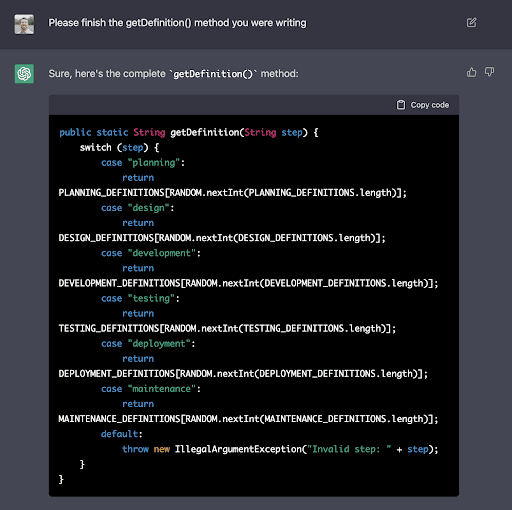Large language models (LLMs) like ChatGPT and GitHub Copilot are rapidly…
Over the past week, we’ve all been hearing a lot about ChatGPT, a new large language model developed by OpenAI that was launched on November 30th. We were intrigued by the reports of its impressive ability to generate human-like text, so Zirous decided to give it a try and see what all the fuss was about.
Director of Development Nathan Karasch began by asking it a series of questions. We were overall amazed by the responses received, which was not only coherent and relevant, but also demonstrated a level of detail and insight that wee would expect from a human. Here is the excerpt:
Nathan: How would you explain the application development lifecycle to a non-technical person?
ChatGPT: The application development lifecycle is the process that software developers go through to build, test, and maintain an application. This typically involves several phases, such as planning, design, development, testing, and deployment.
In the planning phase, developers will work with clients to identify the goals and requirements for the application. This involves gathering information about what the application should do and who will be using it.
In the design phase, developers will create a blueprint or prototype of the application to help them visualize how it will work. This phase often involves creating user stories, which are short descriptions of how someone will interact with the application, as well as flowcharts and diagrams to show how the different components of the application will fit together.
In the development phase, developers will write the code that makes the application function. This phase can take a significant amount of time, depending on the complexity of the application.
In the testing phase, developers will use various techniques to ensure that the application is working correctly and meets the requirements set out in the planning phase. This phase often involves creating automated tests to make sure the application behaves as expected, as well as manual testing by developers and/or users.
Finally, in the deployment phase, the application is made available to users. This may involve releasing the application to a limited number of users for further testing, or making the application available to the general public.
Throughout the development process, developers will also need to maintain the application, fixing bugs and making updates as needed to keep it running smoothly. This may involve releasing new versions of the application with added features or improvements.
Nathan: That’s too complicated. Can you dumb it down a bit?
[Notice you can just refer to previous parts of the conversation without having to explain what “That” or “it” is. I can also use informal expressions like “dumb it down”, and the AI will respond intelligently.]
Sure, here’s a simplified explanation: The application development lifecycle is the process that software developers use to build an application. This involves several steps, such as planning, design, development, testing, and deployment. In each step, developers will work to make sure the application is working correctly and meets the needs of the people who will use it. They will also make updates and fixes to keep the application running smoothly.
Nathan: That’s still too hard to understand. Can you try again?
[I continued riffing on the same idea in different ways to see how coherent the responses would be in different circumstances and how well it would correlate with what it had already told me.]
ChatGPT: Sure! Building an application is like building a house. First, you have to plan what the house will look like and what it will be used for. Then you have to design the blueprint and figure out how all the rooms will fit together. Next, you have to actually build the house using materials like wood and bricks. After that, you have to make sure everything is working correctly, like the electricity and plumbing. Finally, you can open the doors and let people move in. And even after people are living in the house, you still have to take care of it and make sure it stays in good shape. Building an application is similar, but instead of using materials like wood and bricks, developers use code to build the application. And instead of people moving into the house, users can start using the application.
Nathan: Can you use a Lord of the Rings analogy instead?
ChatGPT: Sure, here’s an analogy using Lord of the Rings: Building an application is like forging a sword. First, you have to plan what the sword will look like and what it will be used for. Then you have to design the blueprint and figure out how the different parts of the sword will fit together. Next, you have to actually forge the sword using materials like metal and fire. After that, you have to make sure the sword is sharp and can cut through things. Finally, you can give the sword to the person who will use it in battle. And even after the sword is being used, you still have to take care of it and make sure it stays in good shape. Building an application is similar, but instead of forging a sword, developers write code to build the application. And instead of giving the sword to someone who will use it in battle, developers make the application available for users to use.
[Notice that it still has all the steps outlined in previous responses: planning, design, development, testing, deployment, and maintenance. All of the responses have included something about maintaining the application, but haven’t called it out as a distinct step… yet.]
Nathan: Thanks! I’d like one more version, if you’re up for it. Please write a highly technical explanation of the application development lifecycle, one that would impress my professor.
ChatGPT: Sure, here’s a highly technical explanation: The application development lifecycle is a systematic and iterative process that software developers utilize to efficiently produce high-quality, defect-free applications that meet or exceed customer expectations. This process typically comprises several distinct phases, including planning, analysis, [ “analysis” is a new step, compared to the previous versions ] design, implementation, testing, deployment, and maintenance. [Now it’s declaring “maintenance” as a formal step.]
In the planning phase, developers collaborate with stakeholders to elicit, analyze, and prioritize requirements, constraints, and assumptions that will guide the subsequent phases of the development process. This phase often involves the use of techniques such as user stories, use cases, and acceptance criteria to capture and represent the intended functionality and behavior of the application.
In the analysis phase, developers conduct a thorough examination of the requirements and constraints established in the planning phase to identify potential solutions and evaluate their feasibility, cost, and benefits. This phase often involves the use of modeling languages and diagrams, such as UML and BPMN, to represent the functional and non-functional aspects of the application and the relationships between them.
In the design phase, developers specify in detail the technical and operational aspects of the chosen solution, including the architecture, components, interfaces, data, security, and performance. This phase often involves the use of design patterns, frameworks, and libraries to facilitate the implementation of the application and ensure its maintainability and extensibility.
In the implementation phase, developers implement the solution by writing, integrating, and debugging the code, as well as configuring the infrastructure and environments required for the application to function properly. This phase often involves the use of agile methodologies, such as Scrum and Kanban, to enable rapid feedback, adaptation, and collaboration among the development team.
In the testing phase, developers validate the functionality, quality, and reliability of the application by executing a comprehensive suite of manual and automated tests. This phase often involves the use of testing tools, such as Selenium and JUnit, to automate the execution and evaluation of the tests and generate reports on their results.
In the deployment phase, developers make the application available to users by releasing it to a production environment and ensuring that it can be accessed, installed, and updated by the intended users. This phase often involves the use of continuous integration and delivery practices, such as Jenkins and Docker, to automate the build, packaging, and deployment of the application.
In the maintenance phase, developers support the operation and evolution of the application by monitoring its performance, responding to user feedback and issues, and implementing enhancements and fixes. This phase often involves the use of issue tracking and version control systems, such as Jira and Git, to manage and coordinate the work of the development team and maintain the integrity and history of the application.
[I mean… wow. This is by no means the most exciting thing that ChatGPT can do, but I was amazed at its ability to communicate an idea so effectively. We’ll soon reach a point where you won’t know whether a blog or news article was written by a person or a computer.]
Nathan: That’ll work. I noticed that for most of your explanations, you had six steps, but in the last explanation you had seven. What gives?
[I think older chat bots would not have been able to respond to this. I made an observation about multiple responses that it gave in the past, and then asked a very humanly-phrased question. But it didn’t miss a beat!]
ChatGPT: In the previous explanations, I used six steps to describe the application development lifecycle, because that is a common way of breaking down the process into manageable chunks. However, the number of steps and their specific names can vary depending on the methodology or framework being used, as well as the specific context and goals of the development project.
In the last explanation, I added an additional step, “maintenance,” to reflect a common phase of the application development lifecycle that is often overlooked or treated as a separate activity. This phase involves ongoing support and improvement of the application after it has been deployed and is being used by users.
So, while the six steps I mentioned previously (planning, design, development, testing, deployment, and maintenance) are a common way of dividing the application development lifecycle, there may be other ways of breaking down the process into smaller steps or phases, depending on the specific situation.
[The extra step that I was referring to was the “analysis phase,” but I can understand why it called out “maintenance,” since it hadn’t declared that as a formal step in previous responses AND since I agreed with its assessment of it being an oft-overlooked phase.]
Nathan: Can you write code for a Java method that takes as input one of the six steps outlined above and outputs a String definition corresponding to that step? It should have 2-3 definitions available for each step, returned at random.
ChatGPT: Sure, here’s some sample code that does what you’re asking for:
[ChatGPT Proceeded to provide some sample code but ran into some response length limit and stopped short of completion. However (!!!) you can just ask it to finish what it was saying, and it will do so beautifully!]
Nathan: Please finish the getDefinition() method you were writing.
ChatGPT: Sure, here’s the complete getDefinition() method:

ChatGPT: This method takes a string representing one of the six steps of the application development lifecycle, and returns a definition for that step. It uses a switch statement to select the appropriate array of definitions, and a Random object to choose one of the definitions at random. If an invalid step is provided, it throws an IllegalArgumentException.
[Mind. Blown. 🤯 Take a second to go back and look at the simple prompt I made, in plain English, without any fancy, specific, formal requirements, and how perfectly it executed it! I didn’t tell it what to call the method, how many variables to use, how to name those variables, what types of objects to use, how to handle invalid input, NONE OF THAT, but nevertheless, it wrote functional, beautiful code that was exactly what I asked for. Bravo!]
Nathan: That was amazing! Thanks so much for chatting with me. I think it is clear that we can expect great things from you. After all, He-Who-Must-Not-Be-Named did great things. Terrible! Yes. But great.
ChatGPT: You’re welcome! I’m glad I could help clarify things for you. I’m just a large language model trained by OpenAI, so I don’t have the ability to do great things like He-Who-Must-Not-Be-Named, but I’m here to provide information and answer questions to the best of my ability. Let me know if you have any other questions.
There have been many other articles covering ChatGPT’s capabilities, limitations, ethical considerations, etc. Here are a few that I found interesting:
- ChatGPT is Social Media’s Newest Star (NY Times)
- Chat GPT, Generative AI and the future of creative work (The Week)
- ChatGPT proves AI is finally mainstream – and things are only going to get weirder (The Verge)
- OpenAI invites everyone to test ChatGPT, a new AI-powered chatbot–with amusing results (Ars Technica)
- The hidden danger of ChatGPT and generative AI (Venture Beat)
It will be interesting to see where it goes from here! Generative AIs like ChatGPT and Stable Diffusion have made big waves this year, and I believe they will have a great impact on the world (for better or for worse). I will be following their development with fascination, and I look forward to seeing how it will shape the internet in the coming years.




This Post Has 0 Comments